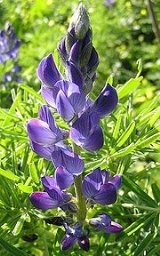
Lupinus angustifolius
Encyclopedia
Lupinus angustifolius is a species of lupin
e known by many common names, including narrowleaf lupine and blue lupine. It is native to Eurasia and northern Africa, and it is naturalized
in parts of Australia and North America. It is cultivated as a food crop for its edible legume seeds and as a fodder
for livestock. Like other legumes the lupine fixes nitrogen
and it is planted in exhausted fields as a soil improver
. Bacteria living in the rhizosphere
of this lupine include the newly discovered species Kribbella lupini.
This is an erect, branching herb sometimes exceeding one meter. Each palmate leaf is divided into 5 to 9 linear leaflets under 4 centimeters long. The herbage is slightly hairy in some areas. The inflorescence
bears many flowers in shades of blue, violet, pink, or white. The fruit is a legume pod containing seeds of varying colors from dark gray to brown to white, or speckled or mottled.
Lupin
Lupinus, commonly known as Lupins or lupines , is a genus in the legume family . The genus comprises about 280 species , with major centers of diversity in South and western North America , and the Andes and secondary centers in the Mediterranean region and Africa Lupinus, commonly known as Lupins...
e known by many common names, including narrowleaf lupine and blue lupine. It is native to Eurasia and northern Africa, and it is naturalized
Introduced species
An introduced species — or neozoon, alien, exotic, non-indigenous, or non-native species, or simply an introduction, is a species living outside its indigenous or native distributional range, and has arrived in an ecosystem or plant community by human activity, either deliberate or accidental...
in parts of Australia and North America. It is cultivated as a food crop for its edible legume seeds and as a fodder
Fodder
Fodder or animal feed is any agricultural foodstuff used specifically to feed domesticated livestock such as cattle, goats, sheep, horses, chickens and pigs. Most animal feed is from plants but some is of animal origin...
for livestock. Like other legumes the lupine fixes nitrogen
Nitrogen fixation
Nitrogen fixation is the natural process, either biological or abiotic, by which nitrogen in the atmosphere is converted into ammonia . This process is essential for life because fixed nitrogen is required to biosynthesize the basic building blocks of life, e.g., nucleotides for DNA and RNA and...
and it is planted in exhausted fields as a soil improver
Soil quality
The proposed a definition, stating that ' is an account of the soil’s ability to provide ecosystem and social services through its capacities to perform its functions under changing conditions...
. Bacteria living in the rhizosphere
Rhizosphere
The rhizosphere is the narrow region of soil that is directly influenced by root secretions and associated soil microorganisms. Soil which is not part of the rhizosphere is known as bulk soil. The rhizosphere contains many bacteria that feed on sloughed-off plant cells, termed rhizodeposition, and...
of this lupine include the newly discovered species Kribbella lupini.
This is an erect, branching herb sometimes exceeding one meter. Each palmate leaf is divided into 5 to 9 linear leaflets under 4 centimeters long. The herbage is slightly hairy in some areas. The inflorescence
Inflorescence
An inflorescence is a group or cluster of flowers arranged on a stem that is composed of a main branch or a complicated arrangement of branches. Strictly, it is the part of the shoot of seed plants where flowers are formed and which is accordingly modified...
bears many flowers in shades of blue, violet, pink, or white. The fruit is a legume pod containing seeds of varying colors from dark gray to brown to white, or speckled or mottled.
Further reading
- Zhukovsky, P.M. (1929). A contribution to the knowledge of genus Lupinus Tourn. Bull. Apll. Bot. Gen. Pl.-Breed. , Leningrad-Moscow, XXI, I:16-294.
- Gladstones, J.S. (1998). Distribution, Origin, Taxonomy, History and Importance. In: J.S. Gladstones et al. (eds.), Lupin as Crop Plants. Biology, Production and Utilization. 1-39.

